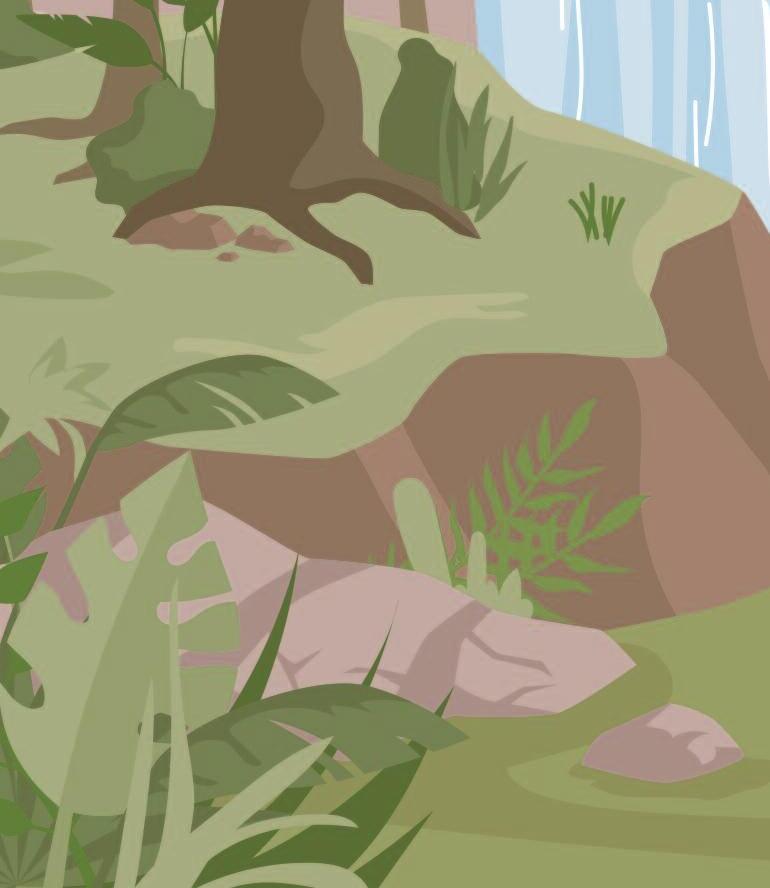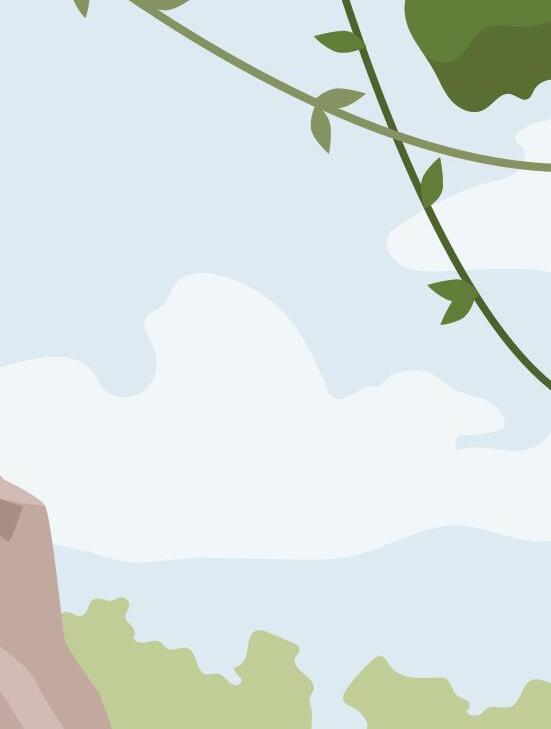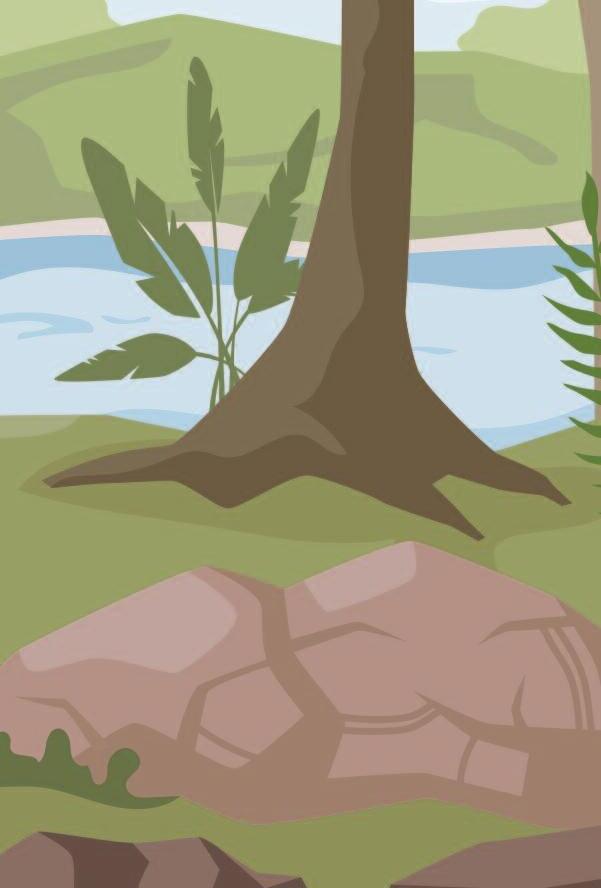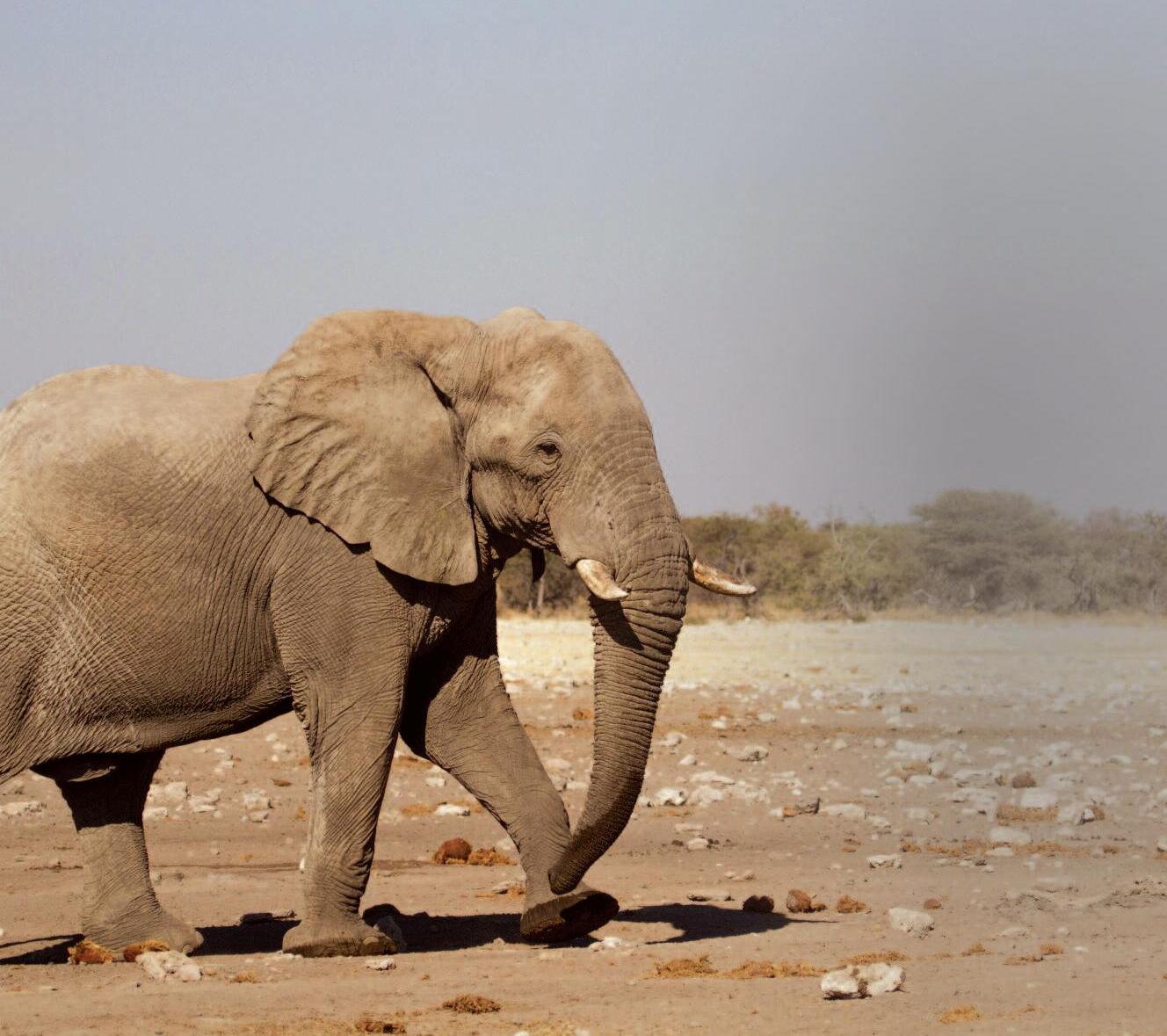l A n i m A l S u p e r h e r o e S
l A n i m A l S u p e r h e r o e S
Discover what makes some species super!
Discover what makes some species super!
l T h e p o S i T i v e p ow e r o f
l T h e p o S i T i v e p ow e r o f
T i n y A n i m A l S little animals that make a big difference.
T i n y A n i m A l S little animals that make a big difference.
l D e l i g h T f u l D u n g
l D e l i g h T f u l D u n g
plant your own gorilla poop!
plant your own gorilla poop!
Plus, all the latest Born Free news!
Plus, all the latest Born Free news!
SUMMER 2024 ISSUE 10


Welcome to Hear The Roar!! In this issue we’re celebrating animal superheroes, who help keep ecosystems healthy.
We sometimes forget wildlife is right on our doorstep, wherever we live! I’m fortunate enough to have lived both in the countryside and cities, but have always appreciated the wildlife around me.

One of my greatest memories as a child, living in the countryside, was spotting hedgehogs in the garden with my mum. I’ve always been amazed at how animals, big or small, play a crucial role in keeping environments balanced and healthy. From hedgehogs eating insects that can damage crops, to foxes and badgers dispersing seeds in their dung – every animal plays a part.
At Born Free, we support many wildlife rescuers in the UK and around the world, returning animals to the wild wherever possible That way, they can continue their good work in helping our ecosystems!
Enya Perry, Youth Engagement Assistant
CONTENTS WELCOME




2
3 Species Spotlight 4 Born Free News 5 Tarnya’s Corner 6 The Positive Power of Tiny Animals 8 Paws For Thought 10 Delightful Dung 12 Animal Superheroes 14 Roar For Nature 15 Quiz Time 16 Wildlife Heroes 17 Ambassador Column 18 Fantastic Facts 19 Be More Boar 20 And Finally…

SPOTLIGHT SPECIES

AFRICAN FOREST ELEPHAN
l There are two species of elephant in Africa – t savannah elephant and the forest elephant.
l Forest elephants are found in dense rainforest of West and Central Africa.

l Forest elephants tend to be smaller than savannah elephants, with straighter, downward facing tusks and rounder ears

l Their diet includes over 300 species of plants, including 72 types of fruit.
l They are Critically Endangered, so conserving t


l They produce enormous quantities of poo, which adds nutrients to the soil, keeping forests healthy!

WHAT IS AN ECOSYSTEM ENGINEER?
An ‘ecosystem engineer ’ is an animal that creates, or changes habitats, which then benefit other animals and plants. These animals have a vital role in keeping habitats healthy and in balance.
African forest elephants are ecosystem engineers Their huge feet trample plants and knock down trees, creating pathways and clearings in the forest This allows more plants to grow, which provides food and shelter for other animals – amazing!

3
© davecu r r ey co m © d a v e c u r r e y c o m


BORN FREE NEWS


ESCUED!
ter their rescue in ar-torn Ukraine
ith the help of atuurhulpcentrum n Belgium, lion brothers Tsar and Jamil finally made the long journey to their forever home at Born Free’s big cat sanctuary in Sha rica. They are both settling in well.
WHAT’S IN A NAME?
Researchers in Kenya were excited to discover elephants call each other by individual names! When communicating, elephants make unique sounds associated with the elephant they are communicating with This is the first time this has been recorded in animals other than humans It shows we still have much to learn about these magnificent animals.
BORN FREE AT 40
It is Born Free’s 40th Anniversary! For the past 40 years, we’ve been a voice for wild animals, whether living in the wild or captivity. We hope our work will not be needed in another 40 years.



WELCOME LEO
Born Free is excited to introduce our newest Junior Ambassador, Le A lover of animals and nature, he has created his own YouTube channel, Leo’s Animal Planet, dedicated to celebrating all things wild





4
© g e o r g e o g a n c o u k
© G l ne VaneB o r n F r ee
© g e o r g e o g a n c o u k
European badger (Meles meles)
Habitat: Broadleaf woodland, farmland, towns and gardens
Diet: Earthworms make up 80% of their diet but they will also eat fruits, cereals, small mammals, insects, slugs and other invertebrates
Lifespan: Up to 16 years, but typically 5-8 years
UK conservation status: Protected




Our Rescue and Care Coordinator, Tarnya, caught up with Folly Wildlife Rescue in Kent, who Born Free has suppor ted for many years.
Hamilton was one of seven badger cubs to arrive in 2023 Tak out of his sett (large burrow where European badger families live) by a dog, his eyes were still closed, and he had small wounds on his neck
After veterinary care, Hamilton was fostered by Hannah, the Wildlife Co-ordinator at Folly Wildlife Rescue. He was bottle-fed every four hours, before progressing onto solids. Just 754g on arrival (less than a bag of sugar), Hamilton weighed around 9kg the time he was released, so was given the nickname Hamil-tan
In September, all seven cubs were released, and a trail camera set up to monitor their progress We’re delighted to repor t there have been regular sightings and they appear to be thriving!


Please seek expert advice if you find an orphaned or injured wild animal.
5
Hamilton
Found across Africa and parts of Asia, honey badgers have a fierce reputation. They can fend off lions and even survive bites from venomous snakes!
The Brawny Badger The Brawny Badger
TI TIN TINY INY

A AN ANI ANIM ANIMA ANIMAL ANIMALS NIMALS P PO POWOWE POWER OWER O OF OF T TH THE HE P PO POS POSI POSIT POSITI POSITIV POSITIVE OSITIVE POWER OF T
TINY ANIMALS CAN HAVE A BIG IMPACT ON THE WORLD AROUND THEM
Even tiny termites improve soil health and create new habitats by building large mounds which then provide protection for plants and other animals.
Dung beetles don’t have the nicestsounding job, but eating and burying dung is vital for the ecosystem. They return nutrients to the ground, improve soil health, help store carbon and control fly numbers by breaking up dung.

6

SMALL MAMMALS ARE HELPFUL TOO
Prairie dogs dig complex tunnels called ‘prairie dog towns’, which provide shelter for other animals such as rabbits, birds, toads and snakes. Their tunnelling also helps keep surrounding grasslands healthy
SMALL but mighTy!
Sometimes, the smallest creatures make the biggest difference. Despite their size, small animals have a big role to play. By protecting them, we can help many larger animals as well.

NOT ALL ECOSYSTEM ENGINEERS WORK ON THE GROUND
Woodpeckers use their beaks to create holes in trees which may later become home to birds who can’t create holes, such as owls.
SOME EVEN WORK IN THE SEA
They might look like rocks or plants, but corals are made up of tiny colourful animals called polyps. Corals provide habitats for many marine animals and help protect the shoreline from damage.


7
WHERE HAVE ALL THE WHERE HAVE ALL THE
graceful, long-legged and quiet are words that may come to mind when ou think about the world’s graceful, long-legged and quiet are words that may come to mind when you think about the world’s

DiDyouknow?
The Swahili word for giraffe is twiga (twee-guh).
pAwS for ThoughT
8
GIRAFFES GONE? GIRAFFES GONE?
Why are giraffes in trouble?
Habitat loss, climate change and illegal poaching have left this gentle giant at risk of extinction. Sadly, some people also hunt giraffes for fun, keeping the giraffe’s skin and body parts as a trophy.




Aren’t giraffes kept safe in zoos?
Giraffes don’t cope well in zoos - being confined to small enclosures can lead to frustration and boredom. Also, giraffes are rarely, if ever, reintroduced to the wild. It is much more effective to protect giraffes in their natural habitat.
RETICULATED GIRAFFE
Population status: Endangered
Habitat: Dry forest, savannah, shrubland.
Diet: Leaves, flowers, twigs and fruits.
Key Facts:
• Their angular patches fit together like a puzzle.
• Help keep habitats healthy by spreading seeds in their dung.
• Under threat – numbers have declined 56% in 30 years.
How can we help giraffes?
Born Free’s ama Twiga Team protects wild reticulated giraffes in Kenya. They monitor giraffe populations, patrol protected areas, and remove snares from giraffe habitats (traps that can injure or kill giraffes and other animals). You can help giraffes too! By using less energy at home and school you can reduce your impact on the earth’s climate and help keep all nature safe.


© g e o r g e l o g a n c o u k © B r i t t a Jhcsa i ksn i FFB 9
D e l i g h T f u l D u n g

everybody poops. you may think it’s gross, but poo plays an important role in keeping our ecosystems healthy! gorillas have similar digestive systems to humans. you can create your own digestive system to discover how gorillas help spread seeds and grow new plants throughout their forest home.
10
G R O W S E E D S F R O M G O R I L L A P O O P!
2

3
you will neeD: p r e pA r e: Protect the floor from mess.
l A tarp
4
C h e w:
Place your fruit in a large bowl and gently crush using the potato masher.
SA l i vA A n D S To m AC h AC i D S: Transfer this into an empty sealable bag and add a little water.
T h e S To m AC h:
Squeeze the bag for a minute crushing the contents into a thick liquid.
5
6
S m A l l i n T e S T i n e:
Cut a small hole in a corner of the bag. Using the funnel, squeeze the contents into the open leg of the tights.
n u T r i e n T A B S o p T i o n:
Hold the tights over another bowl and gently push the food through them, squeezing out liquid as you go.
l A r g e i n T e S T i n e:
8
7 p o o: Squeeze this food to the end of the tights. Cut a hole in the bot tom of the tights and squeeze the contents into the final bowl.
When the food has passed most of the way through the tights, wrap a tea towel around it to absorb any lef tover liquid. The food lef t in the tights represents waste products that cannot be absorbed.


once you have maDe your gorill a poo, pl ant it in a small pot with some peat - free compost anD watch the seeDlings grow!
l Three large bowls
l Potato masher or fork
l Transparent sealable bag
l Some bananas
l Some whole tomatoes
l A few blackberries (optional, but a gorilla ’s favourite)
l Water
l Funnel
l One leg from an old pair of tights
l Tea towel
l Scissors
l Plant pots
l Peat-free compost like this activity?
You can find lots more free, fun activities and lessons on Born Free’s Education pages:
www.bornfree.org.uk/ teaching-resources
11
t e p s
s
1
Let’s give our thanks to the superheroes of the animal kingdom! Let’s give our thanks to the superheroes of the animal kingdom!
ANIMAL ANIMAL ANIMAL
Lots of familiar species are considered animal heroes.
But why?
Hero animals – such as lions, elephants, tigers and even hyenas – have an especially important role to play in their environment.
Ecosystem Engineers Ecosystem Engineers

Elephants are considered heroes because they are ‘ecosystem engineers’ (see more on page 3).
Elephants are considered heroes because they are ‘ecosystem engineers’ (see more on page 3).
They change their environment as they move around, creating new habitats for others to live in and enabling plants to grow. They even dig with their tusks to find water during times of drought, benefitting other animals that would otherwise be unable to reach the water.
They change their environment as they move around, creating new habitats for others to live in and enabling plants to grow. They even dig with their tusks to find water during times of drought, benefitting other animals that would otherwise be unable to reach the water.

12
SUPER
HEROES



CLEAN UP CREW!
umbrella species
Some animal heroes are known as an ‘umbrella species’ and tigers are a great example. They require huge areas of forest, so by protecting tigers and their habitat, we also protect pangolins, sloth bears, Indian gaur, langurs… In fact, hundreds of animals and plants living in the landscape!
Some animal heroes are known as an ‘umbrella species’ and tigers are a great example. They require huge areas of forest, so by protecting tigers and their habitat, we also protect pangolins, sloth bears, Indian gaur, langurs… In fact, hundreds of animals and plants living in the landscape!

Even traditionally unloved animals can be heroes. Hyenas are one of the planet’s most misunderstood animals, viewed as pests by many.
Even traditionally unloved animals can be heroes. Hyenas are one of the planet’s most misunderstood animals, viewed as pests by many.
Yet they are animal heroes too! Hyenas clean the landscape by helping remove dead animal carcasses, preventing the spread of disease. Without hyenas, grasslands would quickly become very smelly!
Yet they are animal heroes too! Hyenas clean the landscape by helping remove dead animal carcasses, preventing the spread of disease. Without hyenas, grasslands would quickly become very smelly!

13 © t i g e r s i n t h e f o r e s t c o u k

FOR NAT ROAR OAR




“i love animals and really want to protect them, especially those that are endangered like the hedgehog. ”

“i can’t imagine a world without animals. i love nature and going outside, and want to save nature for us all to enjoy.”
“i want to help change the school and the world to help wildlife. we should do more litter picks and encourage each class to plant flowers for bees.”


The Discovery School
The Discovery School’s Eco Council works hard to make sure their school helps protect local species. Some students discuss their recent project, focussed on hedgehogs:
“The school were tasked to make a ‘Pledgehog’! This creative representation of a hedgehog includes promises, or pledges, to help our prickly garden friends Pledges include not littering and creating hedgehog-friendly spaces ”
Tell
14
us
wildlife Send your
and
to
org uk (please ask your
or
getting in touch) For fundraising ideas visit: www.bornfree.org.uk/education-fundraising
about what you or your school have been up to for
stories
pictures
education@bornfree
parent, guardian
teacher before
Quiztime
Quiztime
WHAT ARE CORALS?
A) Colourful rocks
B) Animals
C) Plants
NEW RESEARCH SHOWS THAT ELEPHANTS…
A) call one another by names
B) have excellent eyesight
C) can understand other animals
WHAT IS THE SWAHILI WORD FOR GIRAFFE?
A) Tembo
B) Simba
C) Twiga
HOW LONG WAS THE LONGEST RECORDED BEAVER DAM?
A) 75 metres
B) 480 metres
C) 850 metres
WHAT HOME DOES A EUROPEAN BADGER LIVE IN?
A) A holt
B) A sett
C) A nest
HIPPOS MOSTLY EAT…
A) …fish
B) …lilypads
C) …grass
Spot the Difference!
There are three recognised species of elephants. They might look similar, but there’s a few ways you can tell them apart. Can you spot the differences between the species?



Here are a few hints: Have a look at their tusks, their skin and their ears.
15
HINT:
1 2 5 3 6
ALL QUIZ ANSWERS CAN BE FOUND IN THIS MAGAZINE
African
African Forest Elephant Asian Elephant © d a v e c u r r e y c o m 4
Savannah Elephant

Heroes Wildlife Heroes Wildlife

Meet Sandra Reddy, Hospital Director at The Fox Project, supported by Born Free for many years. She has cared for red foxes in need for over two decades!


Tell us about The Fox Project.
We rescue sick and injured foxes in southeast England, helping over 1,200 foxes each year
Foxes in need are treated in our intensive care unit They are then moved to secure outdoor enclosures and cared for until ready to be released back to their home territory.
What’s your favourite thing about working with foxes?
When a fox is returned to health and set free! They speed out of their travel basket to get as far away from us as possible, looking back to check we aren’t following We like to think they are thanking us for bringing them home, though they are more likely thinking, ‘Don’t ever try to catch me again’!


Tell us about a recent rescue. Ziggy and Marley came to us when the owner of the garden they regularly visited got in touch They were suffering from severe mange, which causes endless scratching, hair to fall out and distress. Marley, in par ticular, was in desperate need of our help. After a few weeks receiving treatment and medication to cure mange, they were both released back to their garden territory
Why is it important to care for our local wildlife? It’s extremely impor tant to help wildlife in need Much of Britain's wildlife is disappearing, with the red fox suffering a 45% decline* Protecting the natural environment is the most important thing that we can do
* According to a recent study by the British Trust for Ornithology
Marley before rescue
Marley after rescue
16
© T h e F o x P r o jtce © T he Fox Proj ec t
DID YOU KNOW? DID YOU KNOW?
Red foxes are ecosystem engineers. Feeding and burrowing around their den sites enables new plants to sprout and grow, attracting insects and butterflies, which provide food for birds and other animals.

AMBASSADOR COLUMN


Born Free Youth Ambassador, Hector, explains why it’s so important we phase out the keeping of elephants in UK zoos.
“Remember the nursery rhyme Going to the Zoo? In some versions, there’s a line: we can play all day Yet, for the animals held captive there, there’s not much space for them to play, even if the rhyme sings about a happy elephant with long trunk swinging In fact, there’s not enough space for them to have anything like a natural life
“Out of the eleven zoos in the UK that keep elephants captive, eight have car parks bigger than their elephant enclosure. In the wild elephants can roam over 10 miles a day Elephants in zoos are prevented from living in their natural social groups, causing distress, and their enclosures often cause foot problems Elephants in the UK also live in a colder climate, nothing like what they would experience in their natural, wild habitats
“So next time someone says, "We’re going to the zoo, how about you?", please think of the captive animals kept there – unhappy for a lifetime ”
17
fACTS Fantastic Fantastic

Grazing Gardeners
Despite their ferocious looking teeth, hippos mostly eat grass. Amazingly, their constant grazing creates grass lawns! These lawns provide food for smaller animals and are also thought to help cont rol wild fires in the savannah.

Go with the Flow
Cl-awsome!
Giant ar madillos have the longest claw of any living mammal, coming in at over 17cm long! These claws are per fec t for digging bur rows to raise their young in. Their bur rows are also useful for many other animals to hide from predators or find food.
Beavers build dams across rivers, slowing the flow of water. This causes new areas to flood, creating large wetland habitats Wetlands are great for a variety of wildlife including insects, birds, bats, mammals, fish, and amphibians According to the Guiness World Records, the longest beaver dam measured an incredible 850m long!


Keep Moving
To avoid getting eaten by a predator, her bivores like zebra, need to move around a lot! Being constantly on the move allows grasses eaten by the zebra to regrow and recover Amazingly, this means predators, like lions, help keep grasslands healthy!
18 QUIZ ANSWERS 1 B slaminA .2 C agiwT 3 B A ttes .4 A llac eno rehtona yb seman 5 C 058 sertem .6 C ssarG nacirfA hannavas :tnahpele egraL ,srae devruc ,sksut delknirw niks nacirfA tserof :tnahpele rednuoR ,srae thgiarts ,sksut ,rellams htooms niks naisA :tnahpele llams ,srae dednuor ,kcab ylno selam evah sksut
SPOT THE DIFFERENCE
© g e o r g e o g a n c o u k © Am a r e t a Ke lyC CB Y0 2 C r e a t i v e C o m m o n s
Be MORE boar! Be MORE boar!
Embody a wild boar and create your own wildflower meadow.
Once hunted to extinction in the UK, wild boar can now be found in parts of southern England and Scotland. Boar use their snouts to turn over the soi while looking for food. This uncovers wildflower seeds, which then germinate, creating wildflower meadows.
STEP-BY-STEP GUIDE:
1

If using a pot or container start by getting the soil ready:
a Make sure your container has drainage holes

2
3
4
Place rocks and stones at the bottom to help water drain away
Mix equal amounts of soil and compost. Wildflowers prefer nutrient-poor soil, so mixing elps ensure the soil isn’t too rich
ill the pot with your soil mixture to 2 5cm from he top.
Next, use the trowel or fork to turn or rake the surface of the soil – just like a wild boar might do with their snout!
Sprinkle your seeds thinly and evenly on the surface of the soil, then carefully cover and water.
If you used a pot or container, leave it in a sunny spot to grow, watering when the soil is dry.
YOU WILL NEED:
• Native wildflower seeds
• A suitable pot or containe or even a patch of unused ground
• Peat-free compost
• Garden soil
• Rocks and stones
• A trowel or garden fo GET creative GET creative










19
…have you seen Born Free’s School Events?
Born Free’s Education Team regularly runs webinars for primary pupils It doesn’t matter where your school is based, you and your class can join us for free!
• Get your paintbrushes at the ready, and paint along during our Last Chance to Paint webinars, with creative partner and artist, John Dyer
• Be inspired by nature and amazing authors on World Book Day
• Discover more about the animals that Born Free works to care for and protect
• Have your pupils’ questions answered and learn amazing facts about wildlife!
Teachers - Did you miss our recent World Book Day webinar with amazing author Michael Morpurgo? Find a free recording by visiting our Publications & Resources web page and clicking the webinars
tab You’ll discover Michael’s inspiration behind his classic children’s novel, The Butterfly Lion
www.bornfree.org.uk/publications




View, download and share our paper-free electronic version at: www bornfree org uk/publications Born Free is an international wildlife charity devoted to wild animal welfare and Compassionate Conservation Born Free works to end captive exploitation and Keep Wildlife in the Wild, where it belongs! Born Free Foundation, 2nd Floor, Frazer House, 14 Carfax, Horsham, West Sussex, RH12 1ER Printed on recycled paper www bornfree org uk +44 (0) 1403 240170 Education enquiries: education@bornfree org uk The views expressed in Hear the Roar!! are not necessarily those of Born Free Registered Charity No: 1070906 General enquiries: info@bornfree.org.uk And
AND GO GREEN WITH OUR ONLINE MAGAZINE!
finally...
www.bornfree.org.uk/school-events And finally...






























































































